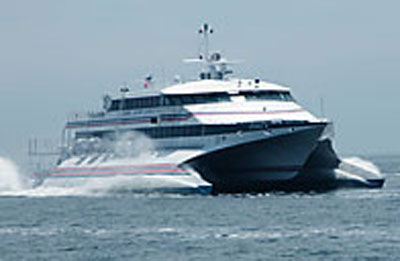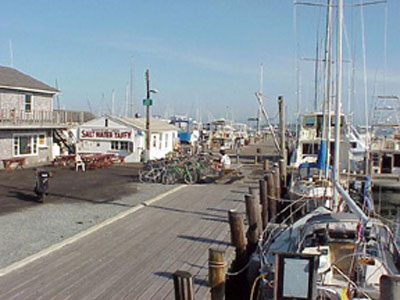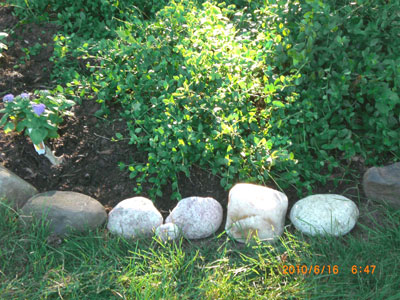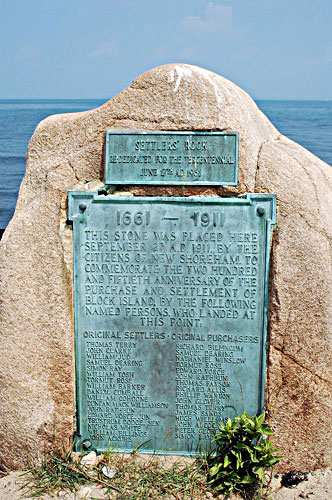 |
 |
|
We boarded the fast ferry to Block Island at 11:30 a.m.
|
Here is the little red jeep we traveled in to see the island
|
 |
 |
| The first place we visited was the Block Island North Light. We parked the red jeep and walked about a mile to get here. On the way, I noticed some beautiful rocks. Well, needless to say, on our way back to the jeep, I had to take some rocks for my rock garden. Donna was very gracious in helping me carry them back to the jeep. Thanks to Evelyn, I was able to bring these rocks back home for my garden. Below you can see the path that we walked on to get here. It was a good workout. | Block Island North Light was established to mark the entrances to Block Island Sound and Long Island Sound, as well as to warn mariners away from dangerous Sandy Point, extending a mile or so from the island. The first lighthouse built here in 1829 consisted of two lights on opposite ends of a building. Two years later, the schooner Warrior was wrecked at Sandy Point in a storm. Twenty-one people died and seven of them were buried on Block Island.
The first building was soon threatened by the ocean, and in 1837 a new lighthouse was built farther inland. Again, two lights were erected at either end of a dwelling. The lights were considered too dim, and mariners complained that they looked like a single light from more than three miles. Another structure was built in 1857, but this one was soon overcome by the shifting sands. The fourth lighthouse at Sandy Point was built by a Fall River contractor at a cost of $15,000, 700 yards from the end of the point. It went into service on September 14, 1868. Hiram Ball had been the keeper of the previous light for six years; he remained at the station for another 30 years. The lighthouse is a handsome granite dwelling with an iron tower. The building is very similar to several other lighthouses built about the same time, including Connecticut's Great Captain Island Light, Sheffield Island Light and Morgan Point Light, and New York's Field Point Light. The new lighthouse received a fourth-order Fresnel lens, exhibiting a fixed white light visible for 13 1/2 miles. The light was later changed to an occulting light, and still later to a flashing light. Block Island North Light was automated in 1956. Donald Lawson of Boston was the last Coast Guard keeper at the station, where he lived with his wife Margaret, a registered nurse, and their one-year-old son, Ricky. In their last winter at the station, heavy snow left the Lawsons stranded and supplies had to be delivered by boat. Donald Lawson enjoyed the fishing and swimming at the station, but wasn't too fond of having to crank the clockwork mechanism that turned the lens, a ritual that had to be repeated every four hours each night. The lighthouse was deactivated in 1973. A skeleton tower a short distance away replaced "Old Granitesides." In 1973 the United States Fish and Wildlife Service acquired Block Island North Light and 28 surrounding acres. It became a wildlife refuge, home to many species of birds. Little attention was paid to the lighthouse, which was the scene of much vandalism. In 1984 the Fish and Wildlife Service sold the lighthouse and two acres of land to the Town of New Shoreham for $1. Much renovation was completed in the next few years, and the North Light Commission convinced the Coast Guard to move the optic from the skeleton tower back into the lighthouse. On August 5, 1989, the lighthouse was relighted, and in 1993 the restored first floor was opened as a museum. On display is a fourth-order Fresnel lens formerly used in the lighthouse. The eventual plan is for a caretaker to live upstairs. To help raise funds, the North Light Commission has sold personalized bricks that have become part of a brick apron around the lighthouse. |
 |
 |
 |
 |
 |
 |
 |
 |
| From here, we went to Dead Eye Dicks which sits on Payne's Dock, overlooking New Harbor. Dead Eye Dick's provides a picturesque view of the water and docked boats of all varieties. The food was very good here. | Our next destination was the Mohegan Bluffs and the Southeast Lighthouse. Standing boldly atop the Mohegan Bluffs of Block Island, the Southeast Lighthouse has testified to the power of ocean storms since its creation in 1874. The tower stands 67 feet high and sits on an octagonal-shaped granite base. Both the keeper's residence and light tower were constructed primarily of brick, with a cast iron lantern gallery perched at the tower's pinnacle. The gallery houses a parapet lantern magnified by a large lens imported from France. The lamp first burned oil, but was converted to kerosene in the 1880s. In 1907, the lamp was replaced with an oil lamp, which increased the light's intensity to 45,690 candlepower. In 1929, a rotating mechanism was installed to accomplish a flashing effect and the signal was changed from a white light to a green light in order to help mariners differentiate between the signals of other nearby lighthouses. The green flash could be seen as far out to sea as 22 miles. In 1990, the U.S. Coast Guard ordered the lamp to be replaced by a white electric aircraft beacon, which remains in the lighthouse today. Perhaps the most notable moment of the lighthouse's history came in 1993, when the 2,000-ton structure was hydraulically lifted from its original location and transported 360 feet inland via a temporary rail system to avoid almost certain destruction by erosion, which had brought the edge of the cliffs within 55 feet of the lighthouse. Today, the lighthouse rests at a location that scientists say should be safe for another century. |
 |
 |
 |
 |
 |
 |
 |
 |
 |
 |
|
Here are the rocks from Block Island. They look so much nicer than the ones from my backyard. I will have to make a yearly pilgrimage to Block Island to replace all of my rocks. :) Thanks again to the girls for putting up with me and my rocks.
|
|
